Content
All issues / Volume 17 (2023) / Issue 6 (June)

This is an editorial article. It has no abstract.
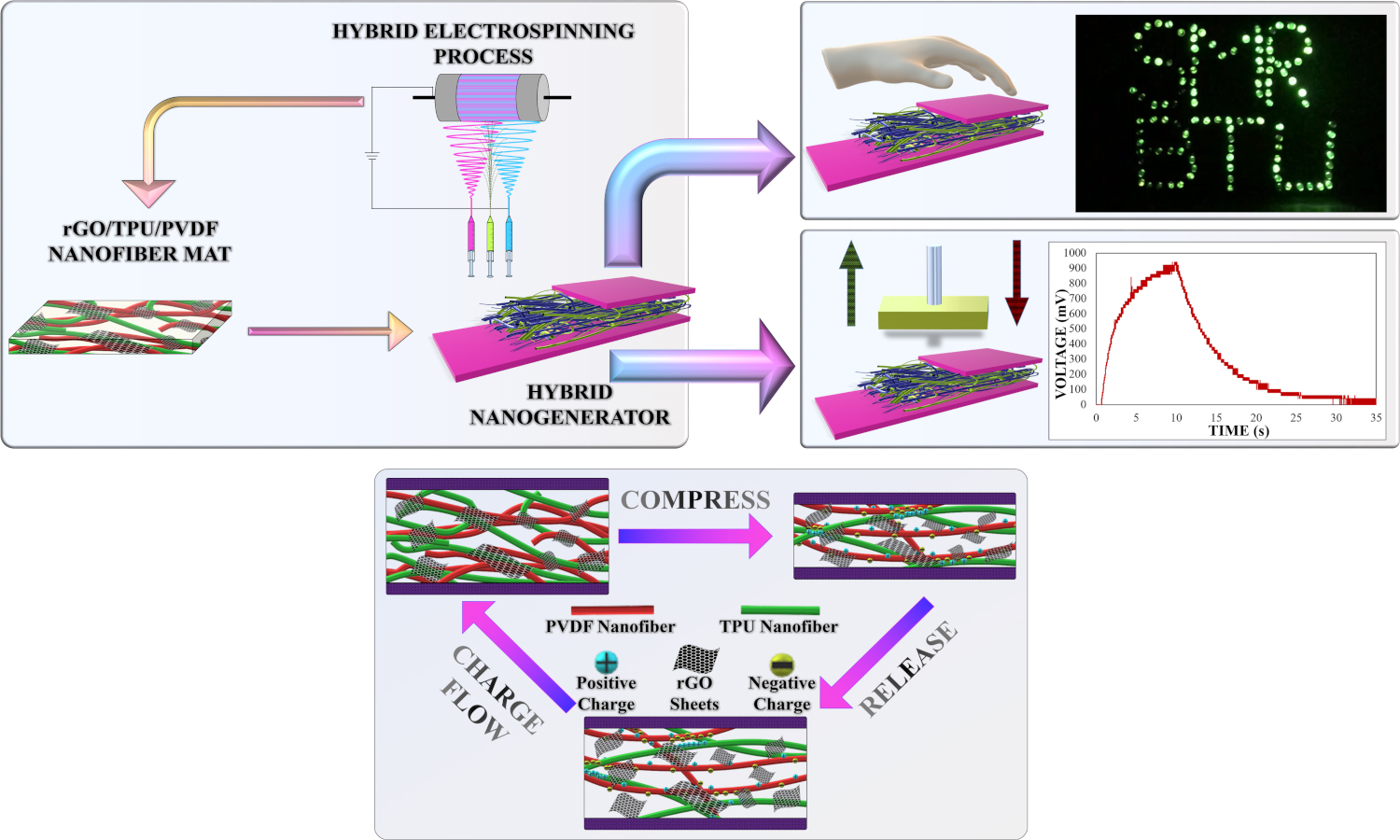
Studies on energy generation devices for necessary energy needs have been an increasing trend all over the world as the kinds and quantities of consumer gadgets have increased. Researchers have been studying nanogenerators for the last 15 years in response to this demand. The three main reasons for these studies are increased output power, application to consumer items, and mechanical stability. Hybrid nanogenerators, on the other hand, are a method of combining at least two energy conversion mechanisms, hence reducing the need for a single conversion mechanism. In this context, while triboelectric-piezoelectric combination hybrid nanogenerators are the most popular hybrid nanogenerator class, they have several drawbacks, such as non-compact and unstable structures. As a result, for the first time, a small hybrid polymer-nanofiberbased hybrid nanogenerator concept with high output voltage and current is disclosed in this study. A hybrid nanofibrous structure was created using an electrospinning apparatus with double and triple nozzles. As a result of the periodic-compression test, the resulting nanogenerators produced a maximum voltage density of 5350 V/m2 and a current density of 5454 A/m2. By hand tapping, the resulting master unit was able to light up 119 LEDs and charge a commercial capacitor up to 0.9 V.

Public health concerns caused by heavy metals present in wastewater have come to global attention. Heavy metal contamination of water resources will have a negative impact on marine species, the environment, and the ecosystem. A variety of wastewater treatment methods have been developed and improvised throughout the decades to counter this issue. Among the wastewater treatment methods, the adsorption method is believed to have a high potential and is suitable for removing heavy metals from wastewater. This review focuses on selecting various types of crosslinked polymer nanocomposites (CPN) as having a significant role in the removal of heavy metals from wastewater via the adsorption method. The adsorption capacity of the CPN was influenced by the polymer types, nanofiller selection, synthesis methods, and exposure conditions. This article will give us important information to improve the functionality of CPN as an adsorbent in wastewater treatment. The challenge, SWOT (strengths, weaknesses, opportunities, and threats) analysis, and future aspects of the CPN are shared in this review.
Polyethylene terephthalate track etched membrane for recovery of helium from helium-nitrogen system
Bipin Chandra Nailwal, Nitesh Goswami, Jayprakash P. Nair, Biju Keshavkumar, Puthiyedath Surendran, Anit Kumar Gupta, Soumitra Kar, Asis Kumar Adak
Vol. 17., No.6., Pages 596-609, 2023
DOI: 10.3144/expresspolymlett.2023.44
Vol. 17., No.6., Pages 596-609, 2023
DOI: 10.3144/expresspolymlett.2023.44

In this work, for the first time, the authors report polyethylene terephthalate (PET) track-etched membrane fabrication and detailed quantitative parametric studies for its application in He–N2 separation. The study also covers theoretical studies to understand the irradiation of PET film with ions as well as the contribution of gas flow domains, which is attempted for the first time. Monte Carlo simulations were carried out using the FLUKA code to evaluate the dose deposited by the ions in the PET film and the displacement per atom (DPA). The distribution of absorbed dose in the film as a function of thickness, the mean absorbed dose as a function of ion energy, and DPA at various depths in the film was determined using these simulations. The range of various ion beams was also calculated using the SRIM code. The effect of incident energy of irradiation beam (Si: 70 and 90 MeV and Cl: 84, 100 and 115 MeV) and etching parameters like concentration of NaOH, temperature, UV radiation, and ultrasonication on the control and irradiated polymer films (~25 μm thickness) were studied. Gas permeation studies of in-house synthesized track etched membrane (optimum) were carried out and a promising He/N2 selectivity of ~2.4 was achieved. The results confirmed that the membranes can have a potential application in the separation of He from natural gas.
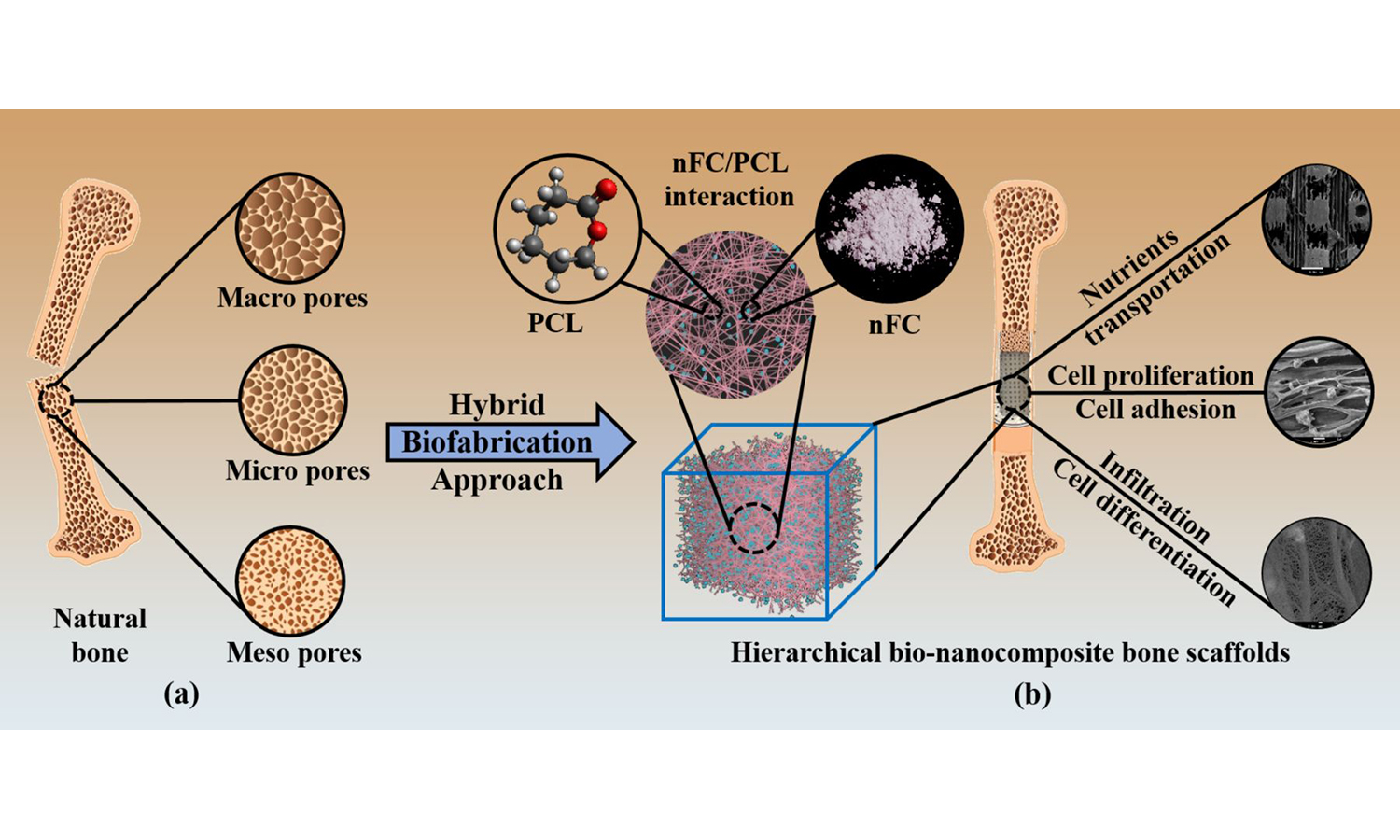
A biomimetic strategy was adopted by incorporating nano-fluorcanasite (nFC) within biocompatible and biodegradable poly-(ε-caprolactone) (PCL) matrix to obtain functionally tuned bio-nanocomposite bone scaffolds. A hybrid approach was adopted using fused deposition modelling, solvent casting and thermally induced phase separation to develop the scaffolds. Phase evolution study through X-ray diffraction revealed dominant crystalline phases (fluorcanasite and fluorapatite) and enhanced crystallinity of the scaffolds. Microstructural investigation through field emission-scanning electron microscopy revealed interconnected gradient porosities and hierarchical (meso, micro and macro) porous architecture within the scaffolds similar to natural bone. The elemental mapping study further confirmed higher calcium:phosphate (Ca:P) ratio upon nFC incorporation, desirable for bone repair. The volume visualisation through X-ray micro-computed tomography confirmed the presence of porous micro-architecture and homogenous dispersion of nFC particulates within the scaffolds. Mechanical performance of the bio-nanocomposite scaffolds was also found to be enhanced to sustain the load against pore collapse. Enhanced cell viability and cellular proliferation response with human osteosarcoma bone cells established the in-vitro biocompatibility of the scaffolds. Finally, this study opens up a unique pathway in the fabrication of biomimetic bone scaffolds with a highly conducive cellular environment.
The synergistic effect of inorganic hybrid nanofibers and phytic acid-based nanosheets towards improving the fire retardancy and comprehensive performance of epoxy resin
Suhua Zhang, Zhenzhong Wu, Shihu Han, Yiqing Wang, Lijun Qian, Xiaoping Hu
Vol. 17., No.6., Pages 625-646, 2023
DOI: 10.3144/expresspolymlett.2023.46
Vol. 17., No.6., Pages 625-646, 2023
DOI: 10.3144/expresspolymlett.2023.46
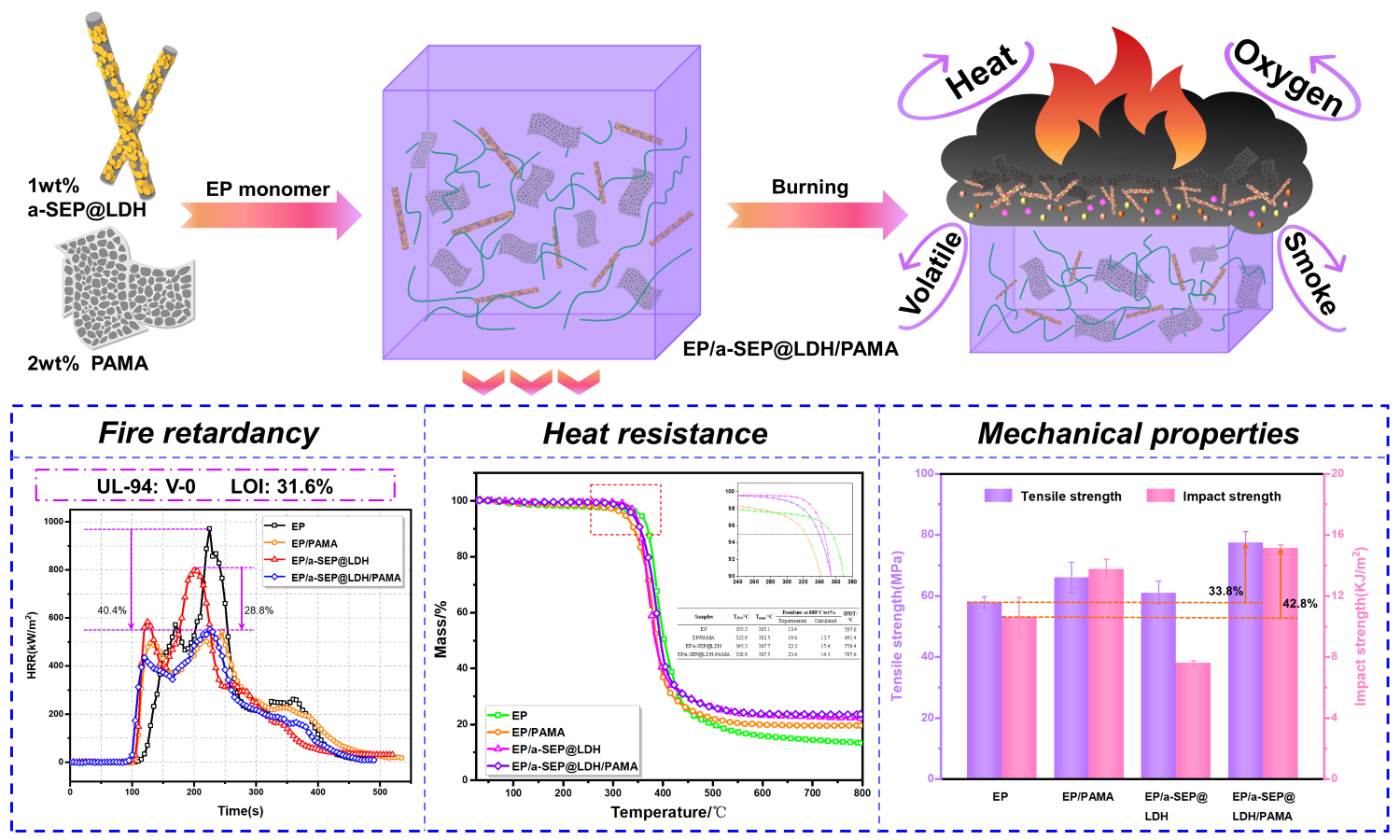
Usually, it is difficult to achieve satisfactory fire retardancy of epoxy resin (EP) at low addition by adding inorganic nano-fillers alone. Herein, sepiolite nanofibers loaded with layered double metal hydroxide (a-SEP@LDH) and phosphorus/nitrogen-containing flame retardant nanosheets (PAMA) were prepared via hydrothermal method, respectively. The UL-94 V-0 rating and an limiting oxygen index (LOI) value of 31.6% were achieved for EP by loading 1 wt% a-SEP@LDH and 2 wt% PAMA. Compared to adding sole a-SEP@LDH, the thermal stability of EP/a-SEP@LDH/PAMA3 was improved significantly, the total heat release (THR) and peak heat release rate (pHRR) decreased by 10.2 and 28.8%, respectively. Additionally, the total CO2 production decreased by 12.5% and the char residue yield increased to 19.9 wt%. Moreover, the tensile strength and impact strength of the EP composites were remarkably improved owing to the incorporation of PAMA. To sum up, this work provides an environmentally benign, low-cost and efficient way for EP to achieve outstanding fire retardance, thermal stability and high mechanical properties at a low addition.
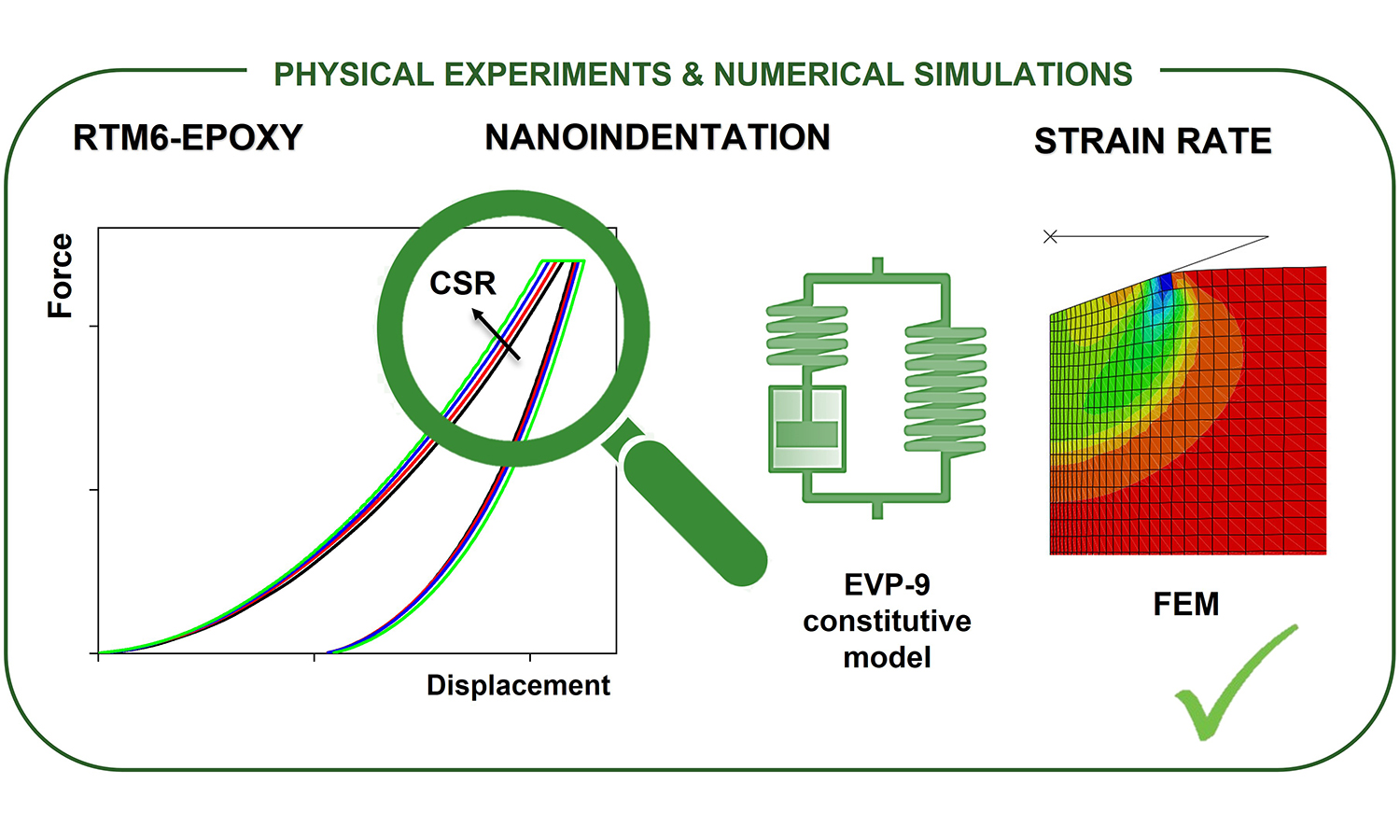
Depth sensing indentation holds the promise of local mechanical properties determination. However, the number of studies on materials that exhibit time-dependent and hydrostatic pressure-dependent behavior is still scarce. This paper aims to understand the effect of loading strain rate on the nano-indentation response of an aerospace epoxy resin by combining physical measurements and numerical simulations. Physical nano-indentation tests were carried out using a Berkovich indenter at different constant loading strain rates (0.01 to 1.25 s–1). It was observed that as the loading strain rate increases, the penetration displacement at which the target load is reached decreases while the maximum displacement attained at the end of the load-hold period increases. The indentation response was numerically simulated to get insight into the phenomenon by finite element analysis. The polymer behavior was described by a nine-parameter elastic-viscoplastic constitutive model (EVP-9). Constitutive parameters were calibrated from uniaxial tensile and compression experimental data. Simulations agreed reasonably well with physical experiments being able to reproduce the loading strain rate effect observed in physical nano-indentation tests.
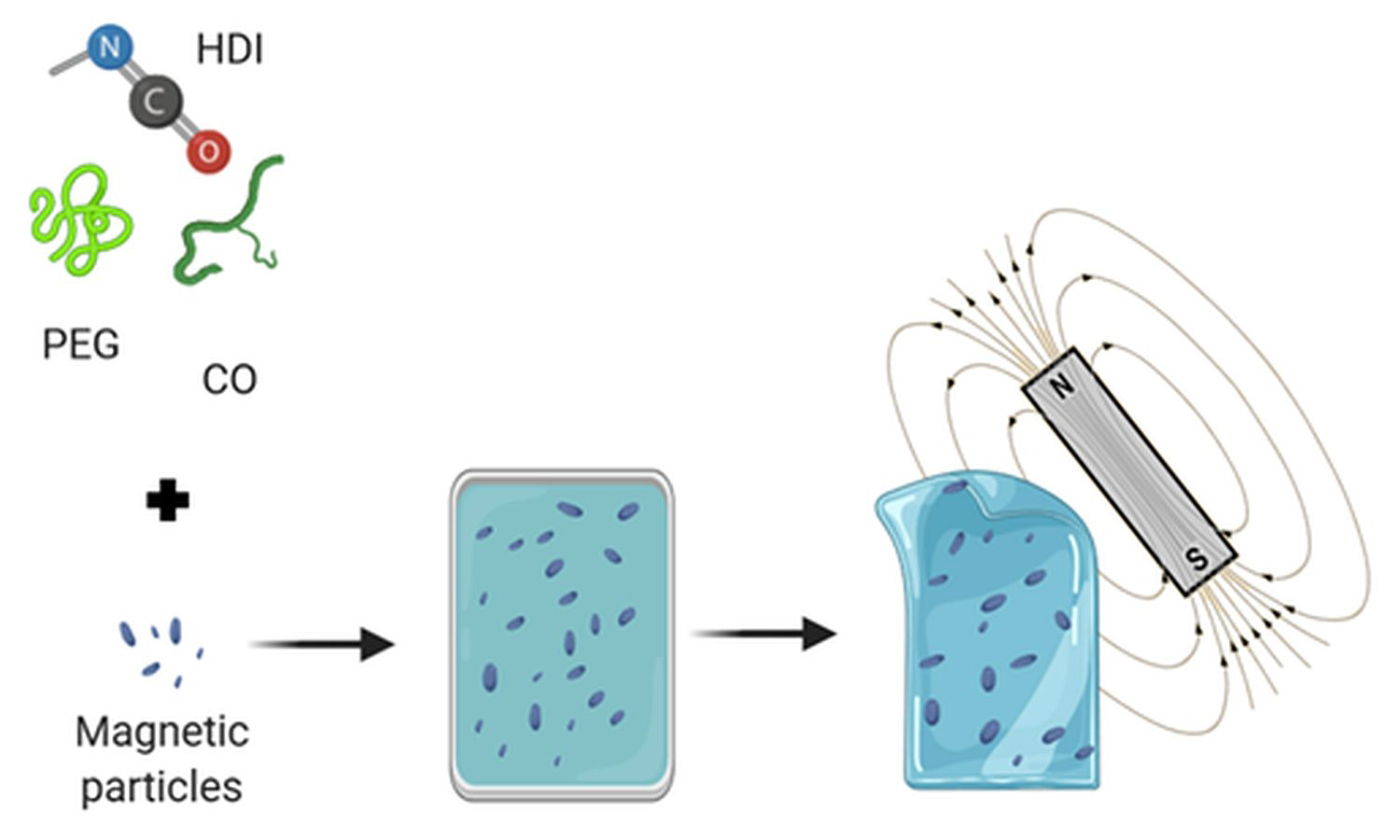
Smart polymers synthesized from renewable sources are precious because of the environmental pressures of producing polymers from fossil fuels. This study develops a new formulation of polyurethane (PU) from partly renewable resources. PU composites were prepared from castor oil (CO), polyethylene glycol (PEG3000), and hexamethylene diisocyanate (HDI). CO was used as both polyol and crosslinker. Butanediol and/or low molecular weight polyethylene glycol (PEG300) were added to the reaction medium as a chain extender. As a magnetic particle, natural magnetite or carbonyl iron was used in various amounts (0–10%). Fourier transform infrared (FTIR) spectroscopy, differential scanning calorimetry (DSC), dynamic mechanical analysis (DMA), scanning electron microscope (SEM), optical microscope, and goniometer were used to characterize all composites and pure PU. A bending test was applied to investigate the shape fixity and shape recovery ratios of the samples. A range of hydrophilic/hydrophobic PU composites (water contact angle is between 56–87°) having various melting and glass transition temperatures were successfully prepared. A PU composite having a good shape recovery ratio (Rr = 96.1%) in a magnetic field was prepared using 10% magnetite. The PU composites were also thermosensitive.


